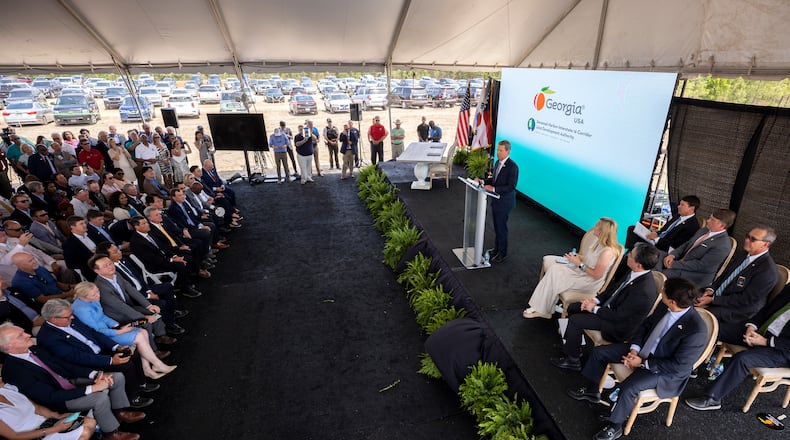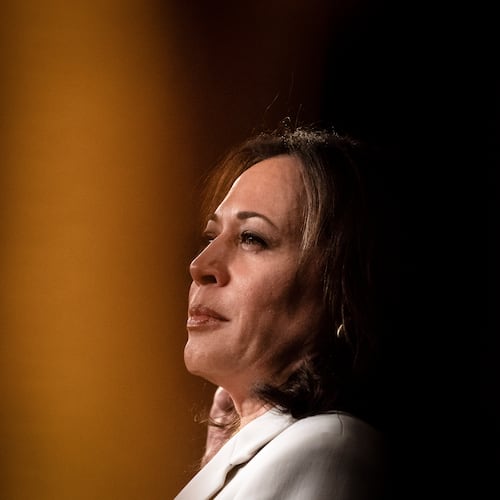SAVANNAH – With a tough midterm election just weeks away, the governor trekked to coastal Georgia to make a game-changing announcement about an auto giant’s ambitious plans to make Savannah a centerpiece of its global strategy.
That governor was Democrat Roy Barnes, who was in the final throes of an unsuccessful 2002 campaign for a second term against Republican Sonny Perdue. And the project he promised, a $754 million DaimlerChrysler plant on Savannah’s outskirts that would have employed 3,000 people, never materialized.
Twenty years later, Gov. Brian Kemp returned to the area to take a victory lap of another sort: The groundbreaking for Hyundai Motor Group’s $5.5 billion “Metaplant.” This project, the largest in Georgia history, is no phantom; work on the 3,000-acre site was underway long before Tuesday’s ceremony.
The timing of the celebration is a boon to Kemp, who is two weeks from a Nov. 8 rematch against Stacey Abrams. Hyundai also did him a favor with its formal announcement of the factory in May, which came just days before the GOP primary.
Kemp wants to frame it as a validation of his economic development strategy to “strengthen rural Georgia” by luring developments both big and small. He said the state has landed 20 electric vehicle suppliers, spurred in part by Hyundai’s plant, as the industry grows.
“That whole part of the world is going to get economic opportunity. A lot of other suppliers are going to go up and down I-16, potentially up and down I-95,” Kemp said. “And that was by design.”
The Hyundai deal also vindicates a quieter, strategic decision made by the Kemp administration.
Credit: Jim Galloway
Credit: Jim Galloway
The sprawling site that Georgia dangled to DaimlerChrysler under Barnes’ watch in the early 2000s was carved up. Mitsubishi secured a portion of the land for a new factory, and the rest was sold to Amazon for a new distribution center.
The state tapped the proceeds to buy a huge tract of land in Bryan County, which officials promptly marketed as the largest undeveloped site in Georgia with direct highway and road access that’s also within 30 minutes of Savannah’s booming port.
Hyundai inked the deal to develop the land earlier this year after a whirlwind courtship that snapped a history of heartbreak for the region.
‘Engines of the future’
With an election looming, Democrats are reluctant to knock a deal that will bring 8,100 jobs to an often-overlooked part of the state. Abrams has instead panned the record $1.8 billion incentive package, which she said should have gone to small businesses.
But even that criticism may be muted. On hand in Savannah to celebrate the deal are Democratic U.S. Sens. Jon Ossoff and Raphael Warnock, who are keen to highlight Georgia’s embrace of alternative energy to help Warnock’s reelection bid.
Credit: Greg Bluestein
Credit: Greg Bluestein
For Barnes, the trip to the coast in the waning days of his 2002 campaign remains a tricky subject.
His administration was certain that DaimlerChrysler selected Georgia after South Carolina, the state’s chief rival for the Sprinter van factory, said it was knocked out of contention. State recruiters told reporters at the time the company signed off on the plan.
But German officials cautioned it was not a done deal, and a year later DaimlerChrysler cited a shaky economy when it officially scrapped the plan.
Barnes said he’s heartened to see the site he once pitched to the auto manufacturer now bustling with commerce, and he said fiscal changes he initiatied to speed Savannah port improvements have paid off.
Now he’s concerned coastal Georgia may be a victim of its own success.
“What is needed now is a way around the Atlanta congestion for the trucks being unloaded in Savannah,” Barnes said. “The port in Savannah and the Atlanta airport are the economic engines of the future.”
About the Author
The Latest
Featured






